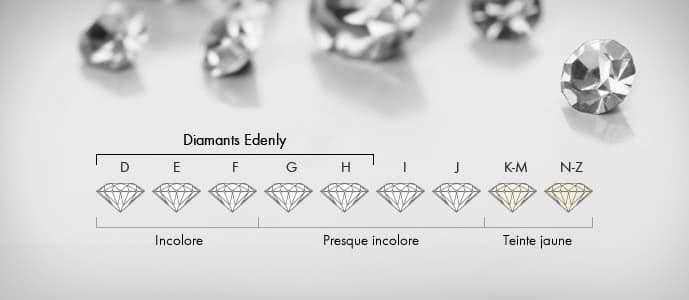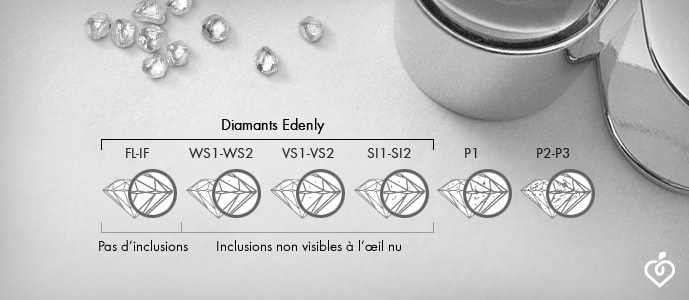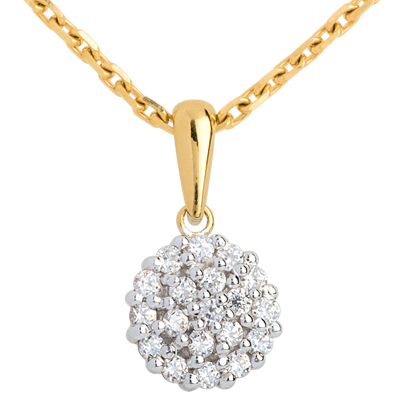"Create" Stone quality
Natural Diamond:
What is a natural diamond?
The natural diamond is one of the most famous and coveted gemstones in the world, renowned for its exceptional brilliance, extreme hardness, and incomparable sparkle. Formed under extreme pressure and temperature conditions deep within the Earth, the diamond is composed of pure crystallized carbon.
What are the physical properties of a natural diamond?
The natural diamond is famous for its hardness, which reaches the top of the Mohs scale with a rating of 10, making it the hardest known substance on Earth. This exceptional hardness makes it extremely resistant to scratches and ensures its long-term durability. In addition to its hardness, the diamond has a great ability to refract light, giving it its unique sparkle and its capacity to shimmer spectacularly. The purity, color, cut, and weight (carat) of the diamond are also key determinants of its value. At Edenly, we guarantee a minimum quality of HSI for your diamonds.
What is the symbol of the diamond?
The natural diamond is often associated with symbols of eternity, purity, and strength. Due to its durability and brilliance, it is considered a symbol of lasting relationships and sincere commitments, making it a popular choice for engagement and wedding rings. Historically, diamonds have also been seen as talismans of protection and power, believed to bring courage, invincibility, and mental clarity to the wearer.
The dazzling beauty and rich symbolism of the natural diamond, combined with its exceptional physical properties, make it the most coveted gemstone in the creation of fine and luxurious jewelry.
Edenly offers certified natural diamonds that meet the highest quality standards. They comply with the Kimberley Process, ensuring that diamonds come from legal sources and are not conflict diamonds.The color of a diamond is measured using the international color scale, which grades them from D (colorless) to Z (yellow hue). At Edenly, you will only find colorless or nearly colorless diamonds (from D to H) whose potential inclusions are not visible to the naked eye (SI).
Edenly provides a certificate with each of its jewelry pieces indicating the weight and quality of the diamond. For custom creations with a diamond greater than 0.50 carat, a certificate from the IGI (International Gemological Institute) will be automatically provided.


En savoir plus sur comment choisir son diamant >
CERTIFICATES
- Edenly provides a certificate of authenticity with each of its jewelry pieces indicating the weight and quality of the diamonds in its creations.
- For jewelry pieces containing a diamond over 0.3 carats, a G.I.A. (Gemological Institute of America) certificate will be automatically provided free of charge. This certificate, issued by one of the most prestigious and globally recognized laboratories, is a guarantee of quality and authenticity. Once examined, the diamond is then delivered in a sealed package with, in some cases, the laser inscription of the certificate number on the girdle. A printed certificate accompanies the diamond, detailing all its specific characteristics. Due to the cost of requesting such certificates (several hundred euros), these are not systematically issued for diamonds under 0.3 carats.
- For certain specific stone cuts (such as marquise cut) or very large stones, an IGI (International Gemological Institute) or HRD certificate may sometimes be provided for double assurance. These are "closed" certificates where the diamond is sealed in a transparent polyester box. However, a written request to the laboratory is necessary.
- Finally, Edenly works only with diamantaires who apply the Kimberley Process, ensuring that diamonds come from legal sources and are therefore not conflict diamonds.

Natural Diamond Cluster:
What is a diamond cluster?
A diamond cluster is a jewelry composition that combines a group of small diamonds arranged to create the appearance of a single large gemstone. Rather than focusing on one large diamond, clusters use multiple small stones set closely together to maximize sparkle and brilliance.
Why choose a diamond cluster?
Diamond clusters are popular for several reasons. Firstly, grouping several small stones can create exceptional sparkle by capturing and reflecting light from multiple angles. Secondly, clusters offer a more affordable alternative compared to purchasing a single large diamond, while still creating a voluminous and impressive appearance.
A diamond cluster combines the splendor of multiple small stones to create dazzling and economically advantageous jewelry. Thanks to their ability to magnify sparkle and brilliance, these subtle arrangements of diamonds continue to attract jewelry enthusiasts seeking beauty and value.
COLORED STONES
Our colored stones adhere to the highest quality standards. This quality refers to the beauty and intensity of the stone's color as well as its transparency and cut quality: "Very Good" at Edenly. Potential inclusions, primarily present in larger gems, are perfectly normal and natural.
Ruby:


What is a ruby?
The ruby is a precious gemstone (like the diamond, emerald, or sapphire) of rare beauty and high value, instantly recognizable by its intense and vibrant red color. The word ruby is derived from the Latin "rubens," meaning "red." Belonging to the corundum family, the ruby shares the same basic chemical composition as sapphire, but is distinguished by the presence of chromium oxide, giving it its characteristic red hue.
What are the physical properties of ruby?
The ruby is an extremely durable stone. With a hardness of 9 on the Mohs scale, it ranks just below diamond in terms of scratch and impact resistance. This durability, combined with its resistance to high temperatures, makes it an ideal gemstone for everyday use and a variety of jewelry settings.
What is the symbol of ruby?
The ruby is also rich in symbolic meaning. Historically, it has been associated with notions of power, courage, and passion. In many cultures, it is also considered a protective stone, believed to bring good fortune and health to its wearer.
The beauty and symbolic significance of the ruby, combined with its exceptional physical properties, make it a highly coveted gemstone in the creation of fine and elegant jewelry.
Synthetic Ruby:
What is a synthetic ruby?
The synthetic ruby is a gemstone created by humans in a controlled environment that replicates the natural formation conditions of rubies in the Earth's crust. Like natural rubies, synthetic rubies belong to the corundum family and share the same chemical composition of aluminum oxide (Al₂O₃) enriched with chromium, responsible for their characteristic red color. The main difference between the two lies in their origin: synthetic rubies are artificially produced in a few weeks or months, whereas natural rubies take millions of years to form.
What are the properties of a synthetic ruby?
Synthetic rubies possess the same physical and chemical properties as natural rubies: it is an extremely durable stone with a hardness of 9 on the Mohs scale, just below diamond. This exceptional resistance to scratches and impacts makes it an ideal gemstone for everyday use. The synthetic ruby also shares the same sparkle and brilliance as its natural counterpart.
What is the advantage of synthetic rubies?
The production of synthetic rubies has a much lower environmental impact compared to mining and avoids the ethical issues often associated with gemstone extraction. Additionally, synthetic rubies are generally less expensive than their natural counterparts, as they are produced on a larger scale without the costs associated with exploration and mining. Controlled laboratory conditions also allow for the production of rubies with exceptional clarity.
The lab-created ruby offers an attractive and ethical alternative to natural rubies. Thanks to advanced manufacturing techniques, these gemstones possess the same physical properties and beauty as natural rubies, while being more affordable and environmentally responsible.
Sapphire:


What is a sapphire?
The sapphire is a precious gemstone (like diamond, ruby, and emerald) of great beauty and value, instantly recognizable by its shades of blue. The word sapphire comes from the ancient Greek "sappheiros," meaning "blue stone." Belonging to the corundum family, the sapphire gets its characteristic color from the presence of iron and titanium in its chemical composition. Although blue is the most famous color, sapphires can also be found in other colors (at Edenly, we offer pink and yellow sapphires).
What are the physical properties of sapphire?
The sapphire is an extremely durable stone with a hardness of 9 on the Mohs scale, just below diamond. This exceptional resistance to scratches and impacts makes it an ideal gemstone for everyday use. In addition to its hardness, the sapphire is also very chemically stable, making it resistant to many chemicals and daily wear.
What is the symbol of sapphire?
The sapphire is associated with symbols of wisdom, truth, and fidelity. Its calming blue color evokes feelings of tranquility, serenity, and mental clarity. Historically, it has been considered a royal and divine stone, believed to protect its wearer and bring inner peace. In many cultures, the sapphire is also seen as a protective stone, bringing blessings and repelling negative energies.
The fascinating beauty and rich symbolism of sapphire, combined with its exceptional physical properties, make it a highly coveted gemstone in the creation of fine and elegant jewelry.
Synthetic Sapphire:What is a synthetic sapphire?
The synthetic sapphire is a gemstone created by humans in a controlled environment that replicates the natural formation conditions of sapphires in the Earth's crust. Like natural sapphires, synthetic sapphires belong to the corundum family and share the same chemical composition of aluminum oxide (Al₂O₃). The main difference between the two lies in their origin: synthetic sapphires are artificially produced in a few weeks or months, whereas natural sapphires take millions of years to form.
What are the properties of a synthetic sapphire?
Lab-grown sapphires possess the same physical and chemical properties as natural sapphires: it is an extremely durable stone with a hardness of 9 on the Mohs scale, just below diamond. This exceptional resistance to scratches and impacts makes it an ideal gemstone for everyday use.
What is the advantage of synthetic sapphires?
The production of synthetic sapphires has a much lower environmental impact compared to mining and avoids the ethical issues often associated with gemstone extraction. Additionally, synthetic sapphires are generally less expensive than their natural counterparts, as they are produced on a larger scale without the costs associated with exploration and mining. Controlled laboratory conditions allow for the production of sapphires with exceptional clarity.
The lab-grown sapphire offers an attractive and ethical alternative to natural sapphires. Thanks to advanced manufacturing techniques, these gemstones possess the same physical properties and beauty as natural sapphires, while being more affordable and environmentally responsible.
Emerald:


What is an emerald?
The emerald is a precious gemstone (like diamond, ruby, or sapphire) of captivating beauty and high value, instantly recognizable by its intense and lush green color. The word emerald comes from the ancient Greek "smaragdos," meaning "green stone." Belonging to the beryl family, the emerald owes its distinctive hue to the presence of chromium and vanadium in its chemical composition.
What are the physical properties of an emerald?
The emerald is a stone with a hardness of 7.5 to 8 on the Mohs scale, making it less hard than diamond, ruby, or sapphire, but still durable and resistant. The emerald is distinguished by its "jardin." The emerald's jardin refers to the natural inclusions present inside this gemstone. The term "jardin" originates from the often green and complex appearance of these inclusions, evoking a miniature landscape embedded in the gem. These inclusions often add a unique charm to each gemstone, giving each emerald a singular appearance and fascinating internal texture.
What is the symbol of emerald?
The emerald has long been associated with symbols of rebirth, life, and nature. Its vibrant green color evokes growth, fertility, and balance. Historically, it has also been considered a stone of foresight and protection. In addition, the emerald is often associated with love and harmony, making it a popular choice for engagement rings and other symbolic jewelry.
The captivating beauty and rich symbolism of emerald, combined with its unique physical properties, make it a highly coveted gemstone in the creation of fine and elegant jewelry.
Synthetic Emerald:
What is a synthetic emerald?
The synthetic emerald is a gemstone created by humans in a controlled environment that replicates the natural formation conditions of emeralds in the Earth's crust. Like natural emeralds, synthetic emeralds belong to the beryl family and share the same basic chemical composition, comprising silicon dioxide (SiO₂) enriched with chromium and/or vanadium, giving them their characteristic green color. The main difference between the two lies in their origin: synthetic emeralds are artificially produced in a few weeks or months, whereas natural emeralds take millions of years to form.
What are the properties of a synthetic emerald?
Synthetic emeralds possess the same physical and chemical properties as natural emeralds. They have a hardness of 7.5 to 8 on the Mohs scale, making them relatively resistant to scratches and impacts, although less hard than diamonds or sapphires. Synthetic emeralds share the same vibrant green color and vitreous luster as their natural counterparts and may exhibit similar inclusions, known as "jardins."
What is the advantage of a synthetic emerald?
The production of synthetic emeralds has a much lower environmental impact compared to mining and avoids the ethical issues often associated with gemstone extraction. Additionally, synthetic emeralds are generally less expensive than their natural counterparts, as they are produced on a larger scale without the costs associated with exploration and mining. Controlled laboratory conditions allow for the production of emeralds with exceptional clarity.
The synthetic emerald offers an attractive and ethical alternative to natural emeralds. Thanks to advanced manufacturing techniques, these gemstones possess the same physical properties and beauty as natural emeralds, while being more affordable and environmentally responsible.
Pink Sapphire:


What is a pink sapphire?
The pink sapphire is a precious gemstone belonging to the corundum family, remarkable for its shades ranging from pale pink to vibrant pink. This characteristic hue is due to traces of chromium in its chemical composition. Naturally formed under specific geological conditions, pink sapphires are primarily extracted from regions like Sri Lanka, Madagascar, Tanzania, and Myanmar. With a hardness of 9 on the Mohs scale, these stones are both beautiful and durable, perfect for creating elegant and refined jewelry.
Is the pink sapphire a real sapphire?
Yes, the pink sapphire is a real sapphire. Like all sapphires, it belongs to the corundum family and shares the same basic chemical composition, primarily composed of aluminum oxide. What sets it apart from other sapphires is the presence of traces of chromium, which give it its unique pink hue. In terms of durability, hardness, and brilliance, the pink sapphire possesses all the qualities of other sapphires, making it an authentic and highly prized gemstone in jewelry making.
What is the symbol of the pink sapphire?
The pink sapphire is often associated with symbols of passion, tenderness, and love. Its delicate and romantic color evokes feelings of softness, compassion, and emotional warmth. In jewelry making, it is frequently chosen to symbolize deep and sincere romantic relationships, making it a popular stone for engagement rings and other symbolic jewelry. Additionally, the pink sapphire is also seen as a symbol of elegance and timeless beauty, adding a touch of refinement to any jewelry piece.
Yellow Sapphire:


What is a yellow sapphire?
The yellow sapphire is a precious gemstone from the corundum family, prized for its shades ranging from pale yellow to vivid and golden yellow. This luminous color is due to the presence of small amounts of iron in its chemical composition. Formed under specific geological conditions, yellow sapphires are primarily mined in regions such as Sri Lanka, Madagascar, Myanmar, and Thailand. With a hardness of 9 on the Mohs scale, these gemstones are not only dazzling but also extremely durable, making them ideal for creating refined jewelry.
Is the yellow sapphire a real sapphire?
Yes, the yellow sapphire is a real sapphire. Like all sapphires, it belongs to the corundum family and shares the same basic chemical composition, primarily consisting of aluminum oxide. What sets the yellow sapphire apart from other sapphires is the presence of traces of iron, which gives it its characteristic golden hue. In terms of durability, hardness, and brilliance, the yellow sapphire possesses all the qualities of other sapphires, making it an authentic and highly appreciated gemstone in jewelry.
What is the symbol of the yellow sapphire?
The yellow sapphire is associated with symbols of joy, prosperity, and wisdom. Its radiant color evokes feelings of happiness, positive energy, and mental clarity. In jewelry, it is often chosen to symbolize abundance and success, making it a significant choice for pieces marking important life milestones. Additionally, the yellow sapphire is also seen as a symbol of light and warmth, adding a bright and sunny touch to any jewelry creation.
Blue Topaz:


What is blue topaz?
Blue topaz is a semi-precious stone of great beauty and value, instantly recognizable by its brilliant blue shades. The name "topaz" likely derives from the Sanskrit word "tapas," meaning "fire." Blue topaz is generally transparent with a vitreous luster, giving it a remarkable brilliance once cut and polished. With a hardness of 8 on the Mohs scale, it is resistant to scratches and impacts, although less hard than diamonds and sapphires. This robustness makes it suitable for everyday use.
What is the symbol of topaz?
Blue topaz is often associated with symbols of communication, wisdom, and peace. Its serene blue color evokes feelings of tranquility, mental clarity, and relaxation. Historically, it has been considered a stone of protection and clairvoyance, believed to promote intuition and repel negative energies. In many cultures, blue topaz is also seen as a talisman of luck and prosperity, bringing positive energies to its wearer.
Amethyst:


What is amethyst?
Amethyst is a semi-precious stone recognizable by its shades of violet. The word amethyst comes from the ancient Greek "améthystos," meaning "not drunk," reflecting the ancient belief that the stone protected its wearer from intoxication. Belonging to the quartz family, amethyst derives its characteristic color from the presence of traces of iron and aluminum in its chemical composition.
What are the physical properties of amethyst?
Amethyst is a relatively durable stone with a hardness of 7 on the Mohs scale. This resistance makes it suitable for everyday use while requiring care to avoid scratches from harder stones. In addition to its hardness, amethyst has remarkable transparency and a vitreous luster that become particularly attractive when it is adequately cut and polished. Its stable chemical composition also makes it resistant to many chemicals.
What is the symbol of amethyst?
Amethyst is associated with symbols of serenity, wisdom, and protection. Its soothing violet color evokes feelings of inner peace, mental clarity, and spirituality. Historically, it has been considered a protective talisman, believed to repel negative energies and bring emotional balance.
Amethyst is a versatile and symbolically rich gemstone that has captivated human imagination for centuries. Whether you seek to add a touch of color to your jewelry or benefit from its symbolic qualities of peace and protection, amethyst is an exceptional choice. Its vibrant luster and natural beauty continue to make it a prized and beloved gemstone in the world of jewelry.
Black Diamond:


What is a black diamond?
The black diamond, also known as carbonado, is a unique gemstone characterized by its intense black color and opaque appearance. Unlike traditional diamonds, often prized for their clarity and brilliance, the black diamond is appreciated for its mystery and dramatic allure. Black diamonds form naturally in the Earth's crust and are primarily mined in regions such as Brazil and the Central African Republic. Due to their distinctive appearance and rarity, black diamonds are growing in popularity in modern jewelry, where they are used to create bold and sophisticated pieces.
Is the black diamond a real diamond?
Yes, the black diamond is a real diamond. Like all diamonds, it is primarily composed of carbon and forms naturally under high pressure and high-temperature conditions. What sets the black diamond apart from other diamonds is its unique coloration, caused by the presence of numerous inclusions of graphite, pyrite, or other metallic minerals. Unlike traditional diamonds, which are clear and transparent, the black diamond is opaque and generally has a polished surface to give it a metallic luster. In terms of hardness, it shares the same robustness as other diamonds, making it a durable and prized gemstone for creating original and sophisticated jewelry.
What is the symbol of black diamond?
The black diamond is often associated with symbols of mystery, sophistication, and power. Its dark and intense color evokes unfathomable depth, bringing an enigmatic and dramatic aura. In jewelry, the black diamond symbolizes inner strength, resilience, and protection. It is also perceived as a symbol of individuality and unconventional elegance, ideal for those who seek to express their uniqueness and bold style. Additionally, in some cultures, the black diamond is considered a lucky stone capable of repelling negative energies, further enhancing its allure as a precious and meaningful gemstone.
for Everyone
A PIECE OF JEWELLERY WORTH £500
Your email will never be marketed. By validating, you agree to the Edenly Privacy Policy. +info

